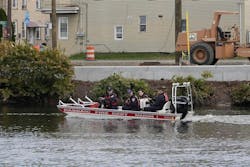In many jurisdictions across the United States, it seems that the frequency of flooding and water-rescue incidents continues to trend upward. The all-hazard approach to the fire service has a large stake in these kinds of operations. Of course, traditionally, many places have been known to flood and create issues. However, it seems more and more areas are flooding that didn’t in the past, and areas that are prone to flooding now are dealing with water that’s moving faster and faster. Are you and your department prepared?
There are many factors that are involved in the answer to the question. If you are a decision-maker in your department, you might be well served to put thought into whether your department has the proper equipment for a response to a water-rescue incident. If you are on the line and involved in operations, you might think about understanding the basics of water rescue enough to not get yourself and your company in trouble at an incident.
Much of the elements of technical rescue revolves around knowing enough to not get the victim further injured and not get yourself and fellow members injured or killed in the field. Yes, there will be times when personnel will go above and beyond to risk a lot to save a lot. By the same token, understanding limitations and capabilities might be the most important thing for everyone who is involved at an incident.
NFPA categories
Depending on your jurisdiction and your response area, your needs vary. If you’re in an area where the waterways are mostly streams and brooks, you might deal with different issues compared with departments that are located in an area that’s surrounded by a river or that is positioned in a coastal region.
The terminology that’s associated with geographic features also might be different from one jurisdiction to the next. In some areas in New Jersey, for example, what’s considered to be a river might be considered a creek in North Carolina. One might be inclined to underrate these terminology differences, but the standardization of language matters when the incident oversaturates the capabilities of a company, department, county, region, etc.
As in many fields of technical rescue, water-rescue training might be broken into a variety of categories through NFPA 1670: Standard on Operations and Training for Technical Search and Rescue Incidents—surface water, swiftwater, flood, watercraft, ice, surf, etc. All of these are broken into awareness, operations and technician levels. As a general rule of thumb, without diving into the specifics of each level, they may be inferred as such: the awareness level refers to technicians knowing how not to get themselves killed; the operations level refers to, for example, technicians intervening with defensive actions, such as throwing rope bags and working off of the water’s edge; and the technician level refers to technicians intervening with offensive action, such as swimming out to conduct a direct-contact rescue. However, you should take all of this information with a grain of salt, because, depending on your department and the department’s jurisdiction, things might change. For this reason, it is absolutely imperative to have the conversation at the kitchen table before the next time that you must respond to one of these incidents.
Reach, throw, row, go, helo
Depending on where you’re from, you might have heard of reach, throw, row, go, helo. Using this phrase as a framework might assist companies in making tactical decisions.
The first step is to keep it simple and try to reach the victim from the shore, perhaps using a pole or any other equipment.
The second step, if the victim is too far to be reached from the shore, is throw a rope or other equipment to them, so you can assist them back to shore.
If the first or second steps don’t’ work, perhaps you can make a grab from a small vessel (row). That said, you must be mindful of operating from a vessel/boat. This step’s in-depth training can be broken down even further.
If row doesn’t work or you don’t have the means, go, meaning take offensive action and make that direct-contact rescue.
If all four prior steps aren’t feasible and the situation calls for it, helo: Bring in the helicopter for the pick off.
Again, many factors influence the decisions that are made at an incident, and they might be fluid. You might arrive to something for which you believe that you might have to launch a boat, but by the time that you engage the victim, the individual is able to follow commands and then swim to you. Other times, you might encounter someone who is lethargic and/or won’t follow commands; the quickest option before the individual goes under is a direct rescue. As in everything we do, the situation dictates our actions.
PPE
When you operate near a body of water, be mindful of your PPE. If your department provides water-rescue PPE, use it as directed in your standard operating guidelines/standard operating procedures (SOGs/SOPs).
Some departments require a dry suit to be donned by members for all water incidents. Further, some departments require, at a minimum, a personal flotation device (PFD) and a helmet.
If you’re near water, be cautious with structural firefighting turnout gear. This PPE has the potential to add almost 60 lbs. of weight to a member in the water plus the added force of the water weighing you down. Many departments have policies that indicate that structural firefighting turnout gear won’t be worn at water incidents. The bottom line as firefighters: If a department invests in equipment and PPE for its members’ use, you must know how to use it and understand when to use it. If you don’t know, don’t hesitate to ask senior members or to read the SOPs/SOGs.
One piece of equipment that might be prove to be extremely beneficial in the process of a water-rescue operation is the water pole/water stick. This 5- or 6-foot piece of ½-inch PVC pipe is capped off on both ends. It’s worth considering that some departments modify it by adding markings every foot (to assist with visually seeing the depth of water that a rescuer is in) as well as by adding rope/webbing handles on either end (to assist with the reach).
Training facilities
Fortunately, in the training world, there are places in the United States that recognized the need for vital training and, as a result, built facilities that are capable of creating water-rescue scenarios without having to put trainees into a river that’s influenced by Mother Nature.
Some of the notable water-rescue training locations include the Fayetteville Technical Community College Swift Water Rescue Training Facility in Fayetteville, NC; the Indiana River Rescue School, which is located in South Bend, IN; the Oklahoma State University Fire Service Training facility, which is located in Stillwater, OK; and the Swift Water and Flood Training Facility at the New York State Preparedness Training Center in Oriskany, NY.
The Fayetteville Technical Community College’s 30-acre, state-of-the-art Swift Water Rescue Training Facility is an indoor, 40 x 80-foot pool that holds 140,000 gallons of water. The pool has an operating depth of as much as six feet. Water conditions in the pool may be adjusted by simply moving the direction of jets to create unique water-rescue scenarios. (The jets can move water at speeds of as much as seven knots, and the temperature of the water can be adjusted, too.) Such scenarios range from basic daytime river-like moving water rescues, to a night storm with rain and an automobile submerged under the water, to a jersey barrier effect, where rescuers must work from only the front or rear of a vessel.
If your department is unable to make it to one of these facilities, don’t quit. Continue to work on your skills. We all worked on throwing throw bags during the day. What about a simple exercise after dinner when the sun goes down? Cracking open a nontoxic glow stick and putting it into your throw bag produces a glowing rope in the throw bag.
Think outside of the box, because, maybe, at your next water response, the rescue company is tied up on some other incident. For example, try to build a simple rope system out of whatever that you have available to you. Maybe you only have a few throw bags, carabiners and pullies. What are you going to do when it’s showtime?
When the call comes in
Think about it and have the discussion. Places that didn’t flood decades ago now are flooding. Places that dealt with minor flooding in the past now deal with swift water. City streets flood, suburban Main Streets flood. As brothers and sisters in the field, it’s our responsibility to stay vigilant and ready to operate should the need arise.
PRODUCT SPOTLIGHT
Boats
For more than 20 years, Moose Boats has built high-quality diesel aluminum catamarans and monohull boats. Each custom-designed vessel is engineered to meet the mission-specific requirements for fire/rescue response and numerous other applications. The vessels are known for their sensible design, durability, comfort, safety, and fit & finish and serve the needs of clients from California to New York and from the Great Lakes to the Gulf of Mexico.
Rigid Hull Inflatable Boat
The Suamico, WI, Fire Department’s new 8M rigid hull inflatable boat was designed by Ocean Craft Marine for search and rescue operations with crew safety and high performance of paramount importance. From the isinglass enclosure of the pilot house, to twin diver-notches for ease of victim recovery, this boat is ready for duty.
Handheld Sonar
AquaEye handheld intelligent sonar from Vodasafe is used by hundreds of teams. The equipment is immediately deployable to search one acre of water in one minute. This short search time line helps to keep teams safe. Onboard intelligence interprets sonar data to indicate where rescue targets are in seconds.











